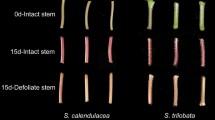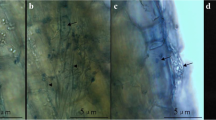Abstract
Mikania micrantha (mile-a-minute weed) is recognized as one of the top 10 malignant weeds in the world. One of its remarkable characteristics is the rapid growth of its stems. The inherent advantages of the photosynthetic characteristics of M. micrantha stems were analyzed in the study. The results indicated that comparing with model plant (Arabidopsis thaliana), vines (Vitis vinifera and Ipomoea nil), C3 plants (Oryza sativa), Crassulacean Acid Metabolism (CAM, Ananas comosus) plants and Asteraceae (Lactuca sativa), M. micrantha had more genes involved in the photosynthetic pathway, light energy capture, carbon fixation and chlorophyll synthesis. From the photosynthetic physiology, with compared to associated vines, M. micrantha stems had a strong net photosynthetic rate (Pn), and had certain advantages in photosynthetic pigment and chlorophyll fluorescence parameters. In a test under high light (HL) conditions, differently from Ipomoea nil, M. micrantha stems showed higher values of Pn, the maximum photochemical efficiency of PSII (Fv/Fm) and contents of flavonoids, total phenols and anthocyanin, while lower hydrogen peroxide (H2O2), malondialdehyde (MDA) and relative conductivity. The qPCR results further showed that chlorophyll a light-harvesting complex (LHCA), chlorophyllide a oxygenase (CAO) and Ribulose-1,5-bisphosphate carboxylase/oxygenase (Rubisco) gene expression levels were decreased in the two species under HL treatment and that the downregulation range was smaller in M. micrantha stems. The inherent advantage of the strong photosynthetic ability of stems is a favorable condition for further enhancing the rapid growth of plants, which may be an important invasion mechanism and provides a new idea for researchers to pay attention to the control strategy of M. micrantha in the future.






Similar content being viewed by others
Data availability
All datasets for this study are included in the manuscript and/or the Supplementary Files.
References
Ainsworth EA, Gillespie KM (2007) Estimation of total phenolic content and other oxidation substrates in plant tissues using Folin-Ciocalteu reagent. Nat Protoc 2:875–877. https://doi.org/10.1038/nprot.2007.102
Cai ML, Zhang QL, Zhang JJ et al (2020) Comparative physiological and transcriptomic analyses of photosynthesis in Sphagneticola calendulacea (L.) Pruski and Sphagneticola trilobata (L.) Pruski. Sci Rep 10:1–12. https://doi.org/10.1038/s41598-020-74289-1
Cai ML, Ding WQ, Zhai JJ et al (2021a) Photosynthetic compensation of non-leaf organ stems of the invasive species Sphagneticola trilobata (L.) Pruski at low temperature. Photosynth Res 149:121–134. https://doi.org/10.1007/s11120-020-00748-5
Cai ML, Lin XH, Peng JJ et al (2021b) Why is the invasive plant Sphagneticola trilobata more resistant to high temperature than its native congener? Int J Mol Sci 22:748. https://doi.org/10.3390/ijms22020748
Clavero M, García-Berthou E (2005) Invasive species are a leading cause of animal extinctions. Trends Ecol Evol 20:110
Day MD, Clements DR, Gile C et al (2016) Biology and impacts of Pacific Islands invasive species. 13. Mikania micrantha Kunth (Asteraceae). Pac Sci 70:257–285. https://doi.org/10.1016/j.tree.2005.01.003
Genty B, Briantais JM, Baker NR (1989) The relationship between the quantum yield of photosynthetic electron transport and quenching of chlorophyll fluorescence. BBA Gen Subj 990:87–92. https://doi.org/10.1016/S0304-4165(89)80016-9
Grodzinski B, Jiao J, Knowles VL et al (1999) Photosynthesis and carbon partitioning in transgenic tobacco plants deficient in leaf cytosolic pyruvate kinase. Plant Physiol 120:887–896. https://doi.org/10.1104/pp.120.3.887
Gu CJ, Tu YI, Liu LS et al (2021) Predicting the potential global distribution of Ageratina adenophora under current and future climate change scenarios. Ecol Evol 11:12092–12113. https://doi.org/10.1002/ece3.7974
Holm LG, Plucknett DL, Pancho JV et al (1977) The world’s worst weeds. Distribution and biology. University Press of Hawaii, Honolulu
Hu YJ, But PPH (1994) A study on life cycle and response to herbicides of Mikania micrantha. Acta Sci Natur Univ Sunyatseni 33:88–95
Huang ZL, Cao HL, Liang XD et al (2000) The growth and damaging effect of Mikania micrantha in different habitats. J Trop Subtrop Bot 8:131–138
Hufbauer RA, Torchin ME (2008) Integrating ecological and evolutionary theory of biological invasions. Biol Invasions Ecol Stud 193:79–96
Jiang ZY, Wang YT, Zheng YP et al (2021) Physiological and transcriptomic responses of Mikania micrantha stem to shading yield novel insights into its invasiveness. Biol Invasions 23:2927–2943. https://doi.org/10.1007/s10530-021-02546-z
Krall JP, Edwards GE (1992) Relationship between photosystem II activity and CO2 fixation in leaves. Physiol Plantarum 86:180–187. https://doi.org/10.1111/j.1399-3054.1992.tb01328.x
Li MG, Lu EB, Guo Q et al (2012) Evaluation of the controlling methods and strategies for Mikania micrantha HBK. Acta Ecol Sin 32:3240–3251
Li Y, Han M, Wang R et al (2021) Comparative transcriptome analysis identifies genes associated with chlorophyll levels and reveals photosynthesis in green flesh of radish taproot. PLoS ONE 16:e0252031. https://doi.org/10.1371/journal.pone.0252031
Liu B, Yan J, Li W et al (2020) Mikania micrantha genome provides insights into the molecular mechanism of rapid growth. Nat Commun 11:1–13. https://doi.org/10.1038/s41467-019-13926-4
Livak KJ, Schmittgen TD (2001) Analysis of relative gene expression data using real-time quantitative PCR and the 2− ΔΔCT method. Methods 25:402–408. https://doi.org/10.1006/meth.2001.1262
Liying S, Lanlan S, Zhan S, Weihua L, Changlian P (2009) Physiological functions of the red leaves of Wedelia trilobata induced by high irradiance in summer. Biodivers Sci 17(2):188–194. https://doi.org/10.3724/SP.J.1003.2009.09007
Luque GM, Bellard C, Bertelsmeier C et al (2014) The 100th of the world’s worst invasive alien species. Biol Invasions 16:981–985. https://doi.org/10.1007/s10530-013-0561-5
Manrique V, Diaz R, Cuda JP et al (2011) Suitability of a new plant invader as a target for biological control in Florida. Invas Plant Sci Mana 4:1–10. https://doi.org/10.1614/IPSM-D-10-00040.1
Mao LZ, Lu HF, Wang Q et al (2007) Comparative photosynthesis characteristics of Calycanthus chinensis and Chimonanthus praecox. Photosynthetica 45:601–605. https://doi.org/10.1007/s11099-007-0103-4
Oxborough K, Baker NR (1997) Resolving chlorophyll a fluorescence images of photosynthetic efficiency into photochemical and nonphotochemical components–calculation of qP and Fv0/Fm0: without measuring Fo. Photosynth Res 54:135–142. https://doi.org/10.1023/A:1005936823310
Park Y, Jung S, Kang S et al (2008) Antioxidants and proteins in ethylene-treated kiwifruits. Food Chem 107:640–648. https://doi.org/10.1016/j.foodchem.2007.08.070
Sales AC, Campos CNS, de Souza Junior JP et al (2021) Silicon mitigates nutritional stress in quinoa (Chenopodium quinoa Willd.). Sci Rep 11:1–16. https://doi.org/10.1038/s41598-021-94287-1
Shen X, Peng S, Chen B et al (2011) Do higher resource capture ability and utilization efficiency facilitate the successful invasion of native plants? Biol Invasions 13:869–881. https://doi.org/10.1007/s10530-010-9875-8
Shen S, Xu G, Clements DR et al (2015) Suppression of the invasive plant mile-a-minute (Mikania micrantha) by local crop sweet potato (Ipomoea batatas) by means of higher growth rate and competition for soil nutrients. BMC Ecol 15:1–10. https://doi.org/10.1186/s12898-014-0033-5
Simberloff D, Martin JL, Genovesi P et al (2013) Impacts of biological invasions: what’s what and the way forward. Trends Ecol Evol 28:58–66. https://doi.org/10.1016/j.tree.2012.07.013
Singhal RK, Kumar V, Kumar S et al (2017) High light stress response and tolerance mechanism in plant. Interdiscip J Contemp Res 4:289–292
Vijayan S, Joy CM (2019) Growth, measurements of invasive plant Mikania micrantha Kunth (mile a minute weed), a threat of biodiversity. Int J Plant Environ 5:23–25. https://doi.org/10.18811/ijpen.v5i01.4
Wang BS, Wang YJ, Liao WB et al (2004) The invasion ecology and management of alien weed Mikania Micrantha H.B.K. Science Press, Beijing
Wang Q, An S, Ma Z et al (2006) Invasive Spartina alterniflora: biology, ecology and management. Act Phytotaxonomica Sinica 44:559–588. https://doi.org/10.1360/aps06044
Wang YH, Han ZM, Han M et al (2010) Effects of shading on the growth and photosynthetic characteristics of Clematis manshurica Rupr. Acta Ecol Sin 30:6762–6770. https://doi.org/10.1080/00949651003724790
Wang MN, Dai ZC, Qi SS et al (2014) Main hypotheses and research progress on the invasion mechanism of alien plants. Jiangsu Agric Sci 42:378–382. https://doi.org/10.15889/j.issn.1002-1302.2014.12.127
Wang JJ, Yu HX, Lai YF et al (2017) Physiological response of the invasive weed Mikania micrantha and the native species Pueraria lobata var. thomsonii to water stress. Biodivers Sci 25:1267–1275. https://doi.org/10.17520/biods.2017284
Wellburn AR (1994) The spectral determination of chlorophylls a and b, as well as total carotenoids, using various solvents with spectrophotometers of different resolution. J Plant Physiol 144:307–313. https://doi.org/10.1016/S0176-1617(11)81192-2
Wen DZ, Ye WH, Feng HL et al (2000) Comparison of basic photosynthetic characteristic between exotic invader weed Mikania micrantha and its companion species. J Trop Subtrop Bot 8:139–146
Yemets O, Gauslaa Y, Solhaug KA (2015) Monitoring with lichens–conductivity methods assess salt and heavy metal damage more efficiently than chlorophyll fluorescence. Ecol Indic 55:59–64. https://doi.org/10.1016/j.ecolind.2015.03.015
Yu HX, Le Roux JJ, Jiang ZY et al (2020) Soil nitrogen dynamics and competition during plant invasion: insights from Mikania micrantha invasions in China. New Phytol 229:3440–3452. https://doi.org/10.1111/nph.17125
Yuan HG, Wang J, Lu HM et al (2004) Study of the biological characteristics Solidago Canadensis. J Shanghai Jiaotong Univ 22:192–195. https://doi.org/10.3969/j.issn.1672-6820.2004.06.002
Zhang LY, Ye WH, Cao HL et al (2010) Mikania micrantha HBK in China–an overview. Weed Res 44:42–49. https://doi.org/10.1111/j.1365-3180.2003.00371.x
Zhang TJ, Chow WS, Liu XT et al (2016) A magic red coat on the surface of young leaves: anthocyanins distributed in trichome layer protect Castanopsis fissa leaves from photoinhibition. Tree Physiol 36:1296–1306. https://doi.org/10.1093/treephys/tpw080
Zhang Y, Shi Y, Gong HJ et al (2018) Beneficial effects of silicon on photosynthesis of tomato seedlings under water stress. J Integr Agr 17:2151–2159. https://doi.org/10.1016/S2095-3119(18)62038-6
Zhang QL, Zhai JJ, Shao L et al (2019) Accumulation of anthocyanins: an adaptation strategy of Mikania micrantha to low temperature in winter. Front Plant Sci 10:1049. https://doi.org/10.3389/fpls.2019.01049
Zheng J, Zhang TJ, Li BH et al (2021) Strong response of stem photosynthesis to defoliation in Mikania micrantha highlights the contribution of phenotypic plasticity to plant invasiveness. Front Plant Sci 12:638796. https://doi.org/10.3389/fpls.2021.638796
Zhu H, Zhang TJ, Zheng JJ et al (2018) Anthocyanins function as a light attenuator to compensate for insufficient photoprotection mediated by nonphotochemical quenching in young leaves of Acmena acuminatissima in winter. Photosynthetica 56:445–454. https://doi.org/10.1007/s11099-017-0740-1
Zu YG, Zhang ZH, Wang WJ et al (2006) Different characteristics of photosynthesis in stems and leaves of Mikania micranth. J Plant Ecol 30:998–1004. https://doi.org/10.17521/cjpe.2006.0128
Acknowledgements
This work was funded by the National Natural Science Foundation of China (3217130145, 31870374).
Funding
National Natural Science Foundation of China, 3217130145, Chang-Lian Peng, 31870374, Chang-Lian Peng.
Author information
Authors and Affiliations
Contributions
MC designed the study, analyzed the data and the drafted the manuscript; LC anlyzed the data and drafted the whole manuscript; WK and MC editing the whole manuscript; JZ, JH and YP participated in the study; CP designed the experiments and reviewed the manuscript.
Corresponding author
Ethics declarations
Conflicts of interest
The authors declare no conflict of interest.
Additional information
Publisher's Note
Springer Nature remains neutral with regard to jurisdictional claims in published maps and institutional affiliations.
Supplementary Information
Below is the link to the electronic supplementary material.
Rights and permissions
Springer Nature or its licensor (e.g. a society or other partner) holds exclusive rights to this article under a publishing agreement with the author(s) or other rightsholder(s); author self-archiving of the accepted manuscript version of this article is solely governed by the terms of such publishing agreement and applicable law.
About this article
Cite this article
Cai, M., Chen, L., Ke, W. et al. Understanding the invasion mechanism of malignant alien weed Mikania micrantha from the perspective of photosynthetic capacity of stems. Biol Invasions 25, 1181–1195 (2023). https://doi.org/10.1007/s10530-022-02973-6
Received:
Accepted:
Published:
Issue Date:
DOI: https://doi.org/10.1007/s10530-022-02973-6




